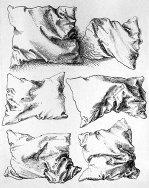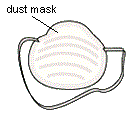
hacksaw - A multi-purpose saw with a narrow blade fixed at each end in a rigid curving frame. Pictured here are typical designs. The lower-left one is designed for more rugged work. The one on the right is generally known as a "jigsaw", and is capable of much finer work, because it can make sharp turns. Blades of various types are available for each. There are also electric motor-powered models with reciprocating blades. A band saw may be an alternative to these.
Also see adze, chisel, circular saw, crosscut saw, file, gouge, kerf, miter, rasp, surform, and wood.
hairstyle -
Also see anastole
and portrait.
Hakuho - A period in Japanese art history from 645-710. It is sometimes called the Early Nara period. The Hakuho period was preceded by the Asuka period (c. 552 - 645) and followed by the Nara period (710-794).
Examples of Hakuho art:

Japan, Hokuho period, 7th century, Standing Avalokitesvara, gilt
bronze, height 31.4 cm, Tokyo National
Museum. Japanese authorities have designated this piece of the
Horyuji Treasure.an "Important Cultural Property."

Japanese, Hakuho period, 707, Cinerary Urn — Container of Ina-no-Omura,
gilt bronze,
height 24.2 cm, excavated at
Kashiba-cho, Kita Katsuragi County, Nara Prefecture; Shitenno-ji
Temple, Osaka. Considered in Japan a "National Treasure".
See cinerary urn.

![]()

halftone art - Printed imagery in which shades of gray are represented by a minute pattern of dots of variable size.
Related link:
Also see benday, lithography, moiré, screen, and stipple.
hallenkirche - In Gothic architecture, especially popular in Germany, a church in which the aisles are as high as the nave; a hall church.
(HAHL-ən-KEER-shə)
hallmark - A mark put on an article to indicate origin, purity, or genuineness. It is usually found on an object's underside. Or a distinguishing characteristic, trait, or feature.
Centuries ago, King Edward I of England decreed that gold and silver had to be tested and approved by master craftsmen before being sold. If tested items met the quality standards of the guild hall's masters, they would be stamped with the mark of the hall -- the special seal of approval of that assay office. These laws have been vigorously enforced, especially since the beginning of the18th century, making it possible to analyze legible marks on British gold and silver to identify its degree of fineness (purity), where and when it was presented for assay, who was responsible for it's manufacture (the maker's mark effectively the artisan's monogram or signature or a company logo), and if a duty was paid. The principal assay office has always been Goldsmith's Hall in London, but goods might also be presented at the provincial assay offices of Birmingham, Chester, Edinburgh, Exeter, Glasgow, Newcastle, Norwich, or Sheffield, each with its own distinctive town or "hall" mark.
At first, English speakers reserved the word "hallmark" for that mark of excellence from official assay offices, but over the years the word has come to name any sign of outstanding talent, creativity, or excellence.
(pr. HAWL-mark)
Examples:



Hallmarks or stamped company monograms used
by William Spratling (American, Texas), stamped
on silver he
produced between 1931 and 1940. A page about these and other Sprattling hallmarks.

Hallmarks or stamped logos of several watchmakers.
Related link:
Also see die, heraldry, sign, and symbol.
halo - A nimbus — a circle of radiant light around the heads of God, Christ, the Virgin Mary, or a saint. A type of gloriole or glory. It indicates divinity or holiness, though originally it was placed around the heads of kings and gods as a mark of distinction. Also see Gothic and Middle Ages, mandorla, and votive.
Also see Madonna.
hammer - See ballpein hammer, bush hammer, claw hammer, mallet, rivet, and tools.
Han - A Chinese dynasty which lasted 206 BCE - 220 CE.
Examples of work from the Han dynasty period:

China, Female dancer, Western Han dynasty (206
BCE
- 9 CE),
2nd century BCE, earthenware
with slip and pigments,
height 21 inches (53.3 cm),
Metropolitan Museum of Art, NY.

China, Ritual Wine Container (Hu), Han dynasty,
1st century BCE
- 1st century CE,
earthenware painted
in green and red, Worcester Art Museum, MA.
China, Three-Storey Watchtower, Eastern Han dynasty (25 CE - 220 CE), a model made for burial, green-glazed pottery, height 130 cm, Henan Museum, China. Unearthed at Lingbao, Henan. Most Han dynasty watchtowers are square in shape. The distance between storeys is relatively great. On every storey there are doors, platforms, balustrades, etc. On many such models of watchtowers figurines of warriors were posted with weapons, showing that watchtowers at that time could serve in the guarding or defending of fortresses.
handbill - A single sheet — a circular or a flier — distributed by hand in public places or to homes or offices.
Also see broadside, brochure, pamphlet, and propaganda.
hand-over-hand - A technique in which a teacher places his or her hand over a student's hand in order to teach a skill manually.
hand puppet - A small, hollow cloth figure, usually of a person or animal, that fits over and is moved by the hand.
Also see marionette.
handscroll and hanging scroll - See scroll.
haniwa - In Japanese tradition, sculptured pottery cylinders, modeled in human or animal figures, or in other forms, and placed in early (archaic) Japanese burial mounds (or "tumuli"). Human-figured haniwa figurines have generally been found in postdating the mid-5th century. Earlier tumuli tend to have non-human haniwa forms, such as canopies, shields, armor and houses. Many human-figured haniwa, including female shamans, dancers, people in full dress, warriors, farmers, harpists, and hawking men, have been found in the Kanto district. Burial styles changed as stone room tumuli became more common. Typically, several types of clay figurines would be arranged in front of the stone room, almost as if they were attendents at the burial.
Examples:

Japan, Kofun
Period, 6th century, Warrior in keiko type armor, terra
cotta haniwa tomb figure,
excavated at Iizuka-cho,
Ota-shi, Gunma, height 130.5
cm, Tokyo National Museum. Japanese authorities consider this
to be a "National Treasure."

Japan, Kofun
Period, 6th century, Dog, terra
cotta tomb figurine, excavated
at Kamidakeshi, Sakai-machi, Gunma, height
46.3 cm, Tokyo National Museum.

Japan, Kofun
Period, 6th century, Male Haniwa Figurine, earthenware, height 75.0 cm, excavated at
Wakiya, Gunma Prefecture. Considered in Japan an "Important
Art Object". This male figure wears a sedge hat and a necklace,
and dresses his hair in the mizura style. He wears a short sword,
and carries a hoe on his right shoulder.

Japan, Tumulus period, 6th-7th century, Male Haniwa Figure, earthenware with
traces of pigment, excavated
in Ibaraki Prefecture, Asia Society, NY.
Happening or happening - Happenings were loosely structured theatrical pieces from the mid-1950s through the mid-1960s, which shared qualities of unexpectedness (a large margin for improvisation), variety of means, and chaos, with the reactions of the audience potentially influencing the action under way. Although there are elements of theatricality involved in happenings, they took place without traditionally theatrical participants or environments, and resulted from an evolution in modernist art in which the outside edges of the work are blurred, broken, or nonexistent. This trend sprang from artists' reaching for the means of establishing more direct relationships between artist and audience, and between art and life, simultaneous with their rejection of the market's control of art. A happening might take a political or sociological direction, but it could also take a poetic or playful one. Other terms referring to a happening might make it more of an event, a concert, a performance, or an action.
From the 1950s, some works of music composer John Cage (American, 1912-1992) may be considered as prototypical happenings. Some were highly improvised, incorporating works of multiple performers, visual art, dance, and poetry.
Nine artists in Japan, known as the Gutaï group, including Murakami Saburo, Kudo Tetsumi, and Shiraga Kazvo, focused on the creation of happenings as early as 1955.
The happening gained prominence in the artworld largely through the efforts of Allan Kaprow (American, 1927-). In 1959 Kaprow created 18 Happenings in 6 Parts in the Reuben Gallery in New York. It was Kaprow who coined the term Happening. He defined it as:
No film of a happening was considered by the artists to be the work of art itself, but rather a documentation of it.
Among numerous other artists involved in the early happenings were Red Grooms (American, 1937-), Claes Oldenburg (American, 1929-), Robert Whitman (American), Jean-Jacques Lebel (French), Ben Vautier (French, 1935-), Joseph Beuys (German, 1926-1981), Wolf Vostell (German, 1932-), and "Vienna Actionists": Günter Brus (Austrian, 1938-), Hermann Nitsch (Austrian, 1938-), and Rudolf Schwarzkogler (Austrian, 1940-1969). Some of the above were participants in the Fluxus movement, in which events amounting to happenings were often called "Aktions." Toward the end of the 1960s, two main trends emerged: performance art, which was more structured, sometimes narrative, and reduced the audience's involvement; and Body Art, in which the artist's body became the medium.
Also see commodity, conceptual art, earth art, and environment art.
![]()
haptic - Of or relating to the sense of touch; tactile.
Also see feng shui, memory, mind, motivation, multiple intelligence theory, music, percept, sensitivity, sensorium, synesthesia, tactile, and texture.
hard-edge - Refers to a twentieth century movement in painting in which the edges of shapes are crisp and precise rather than blurred.
A precursor to this kind of painting is:
Henri Matisse (French, 1869-1954), Icarus, 1947, color pochoir, 16 1/2 x 10 1/2 inches (image) 16 1/2 x 25.2 inches (sheet), Metropolitan Museum of Art, NY. See cutout and precursor.
Examples of paintings made in this manner:
Barnett Newman (American, 1905-1970), Day One, 1951-52, oil on canvas, 132 x 50 1/4 inches (335.3 x 127.6 cm), Whitney Museum of American Art, NY.
Agnes Martin (American, 1912-2004)
![]() Ellsworth
Kelly (American, 1923-), Blue, Green, Yellow, Orange, Red, 1966,
oil on canvas,
five panels, 60 x 240 inches overall, Solomon R. Guggenheim Museum,
NY.
Ellsworth
Kelly (American, 1923-), Blue, Green, Yellow, Orange, Red, 1966,
oil on canvas,
five panels, 60 x 240 inches overall, Solomon R. Guggenheim Museum,
NY.

Kenneth Noland (American, 1924-), Shoot, 1964, acrylic
on canvas, 103 3/4 x 126 3/4
inches (263.5 x 321.9 cm), Smithsonian American Art Museum, Washington,
DC. See chevron.
Also see Color
Field painting and Minimalism.
hardness - See Mohs Scale of Hardness.
hardwood - Certain deciduous trees produce wood which is very tough and durable when seasoned. Cherry, mahogany and oak are examples of hardwoods. Also see softwood.

harmika - In Buddhist architecture, a square fence-like enclosure symbolizing heaven on top of the dome of a stupa. In the center of the harmika the yasti arises — a spire with three chatras, or circular disks. The yasti symbolizes the universe.
harmonic sequence or harmonic series - A sequence of numbers in which the terms are in harmonic progression.
Also see Fibonacci sequence, music, and rhythm.
harmonious colors - Colors that look good together because they are complementary colors, analogous colors, or otherwise related.
harmony - Agreement; accord. A union or blend of aesthetically compatible components. A composition is harmonious when the interrelationships between its parts fulfill aesthetic requisites or are mutually beneficial. As a principle of design, harmony refers to a way of combining elements of art to accent their similarities and bind the picture parts into a whole. It is often achieved through the use of repetition and simplicity.
Excessive harmony leads to monotony, boredom. Relieving this may be elements of contrast; even of dissonance.
In music harmony occurs when sounds complement each another when they come together. Harmony found its way into English from Greek and Latin, via French. The Latin harmonia, meaning agreement, joining together, as do the joints of an arm. This became Old French armonie, which emerged by the 14th century in English as armonye.(pr. HAHR-mə-nee)
Quote:
Also see chado, compare, eurythmy, feng shui, harmonic sequence, juxtaposition, music, pattern, rhythm, sublime, tension, unity, and variety.
hashira-e - In Japanese art tradition, a narrow vertical print to be hung. Also called a pillar print.
Examples:
Torii Kiyonaga (Japanese, 1752-1815), After the Bath, hashira-e, c.1781-82, Sweet Briar College, VA.
![]()
![]()
![]()
Attributed to Isoda Koryûsai (Japanese),
Two Untitled Hashira-e — the first and second, pre-1789, color woodblock prints, each 28 1/4 x 4 3/4
inches, Library of Congress, Washington, Prints and Photographs
Division, DC.
Also see hoso-e, kakemono, kakemono-e, and ukiyo-e.
hatching and cross-hatching - Creating tonal or shading effects with closely spaced parallel lines. When more such lines are placed at an angle across the first, it is called cross-hatching. Artists use this technique, varying the length, angle, closeness and other qualities of the lines, most commonly in drawing, linear painting, engraving, and ethnic. Hatching is also referred to with the French word hachure.
A value scale produced with with pen and ink on white paper, by hatching and cross-hatching:

Example artworks:
![]()

Albrecht Dürer (German, 1471-1528), Sechs Kissen (Six Pillows), 1493, ink on paper, 276 x 202 cm. Dürer produced this drawing when he was twenty-two years old. See drapery and Northern Renaissance. There is Andreas Freise's (German, contemporary), 2001 95-line ascii version of this picture. (If you don't find it at that first link, try it here). Email Andreas Freise, Universitaet Hannover.

Giorgio Morandi (Italian, 1890-1964), Still Life with Very Fine Hatching, 1933,
etching on paper,
image: 24.8 x 23.8 cm, Tate Gallery, London. For nearly fifty
years, Morandi devoted himself to the depiction of still life subjects
— a collection of bottles, jugs, tins and boxes that he kept
in his studio.
Jasper Johns (American, 1930-), Usuyuki, 1981, silkscreen, 29 1/2 x 47 1/4 inches (74.9 x 120.0 cm), Metropolitan Museum of Art, NY.
Also see moiré.
haunch - In architecture, the part of an arch (roughly midway between the springing and the crown) at which the lateral thrust is strongest.

 hazardous
- Describes materials or
actions which can be dangerous. Carefully read and follow all
safety warnings.
hazardous
- Describes materials or
actions which can be dangerous. Carefully read and follow all
safety warnings.
In the United States, OSHA (the Occupational Safety and Health Administration, a federal agency) requires that manufacturers of most materials publish "material safety data sheets" that describe how those materials must be handled and disposed of. When in doubt, ask the manufacturer or supplier to send you a copy.

 Acids, adhesives, asbestos, bodily fluids, various pigments, and solvents are among the many art materials that can be tremendously hazardous.
Acids, adhesives, asbestos, bodily fluids, various pigments, and solvents are among the many art materials that can be tremendously hazardous.

See a questionable expert's advice to artists about diet and exercise.
Also see AP,
Art & Creative Materials
Institute (ACMI), ASTM International
(American Society for Testing and Materials), CL,
clean up, fluorescent
colors, flammable, hot glue, hot glue gun, Material
Safety Data Sheet (MSDS), pneumosparklyosis, poison,
toluene, toxic,
and xylene.
https://inform.quest/_art